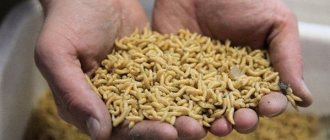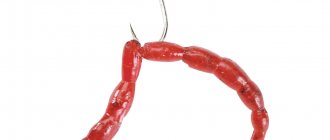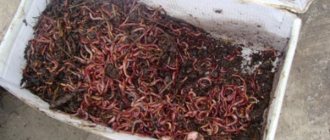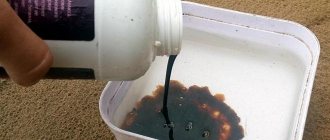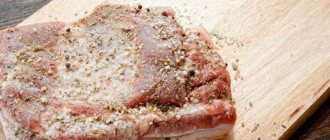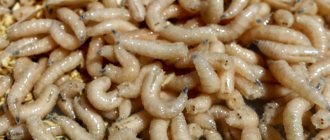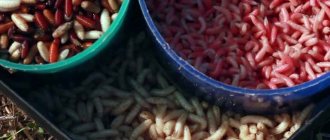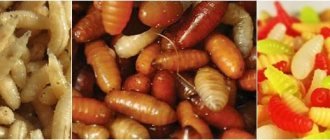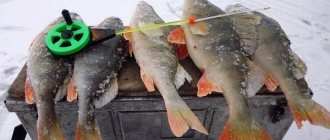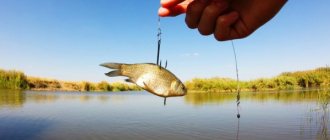Yuri 09/17/2020 3638
Bloodworms occupy a special place among traditional fishing baits. This is a mosquito larva that fishermen use as bait to hook fish. Both predators and carnivorous fish bite on it. The question of storing bloodworms is open. The larvae quickly deteriorate, and the effectiveness of fishing directly depends on the freshness of the bait. Any fisherman will be interested in how to store live bloodworms and make sure that they remain vigorous after a few days.
Long-term storage
To store live bloodworms without allowing the larvae to die, you need to understand the environmental conditions in which the bait must exist. In almost all fishing stores you can buy a dose of these worms for 1-2 fishing trips and store this small amount in the refrigerator for a couple of days with almost no additional manipulations (even in this case there are features that we will discuss below). Amateur fishermen use these larvae more often when fishing in winter, so we will talk about their safety mainly in the cold season.
For fishermen who often go a lot for winter fishing, a reserve supply of large larvae for bait, as well as food bloodworms (liman) in a living state, may be necessary. It is the movement of live bloodworms on the bottom that most strongly attracts fish, which is why feeding with these larvae is so effective. The bream senses the swarming larvae from several meters along the side line.
Keeping bloodworms alive for a long time will be useful when using this bait for sale, as well as for those anglers who plan to wash the larvae themselves and then use them all winter.

Storage conditions
How to store bloodworms for fishing correctly? Storage conditions are determined by the biological characteristics of this mosquito larva. She hatches from an egg in the warm season, feeds and grows. Then it survives the winter in the bottom sediments of the reservoir, and with the onset of a warm period it pupates and turns into an adult mosquito (imago).
Thus, the bloodworm lives in the larval state for a little less than six months. In winter, the temperature of the larvae’s habitat is from 0 to +8 degrees. And this is one of the important storage conditions. This aspect determines at what temperature the bloodworms should be stored at home. Therefore, storing bloodworms in the refrigerator is important for ordinary fishermen. Just about 4 degrees Celsius.
For long-term storage, it is very important not to expose the larvae to large amplitudes of temperature changes and to hold them for a long time at higher thermometer readings. That is why after fishing, unused bait is thrown away. Such bloodworms have already undergone temperature fluctuations and will therefore die within a day or two. Under no circumstances should you return it from a blood bottle you took with you on a fishing trip to the general storage, otherwise the entire volume will be spoiled.
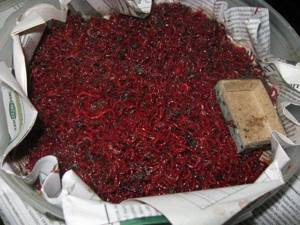
The mosquito larva lives in water, so keeping it in a humid environment is the second most important condition. But there is one peculiarity here. All storage methods can be divided into two large groups:
- Dry (in fact, it would be more correct to say wet).
- In water (conditions similar to the natural habitat are artificially created).
Bloodworms stored “dry” cannot be wetted. But many anglers make this mistake. They wet the larvae, which then quickly disappear because of this. Also, excess moisture during long-term “dry” storage contributes to the appearance of mold, which kills the larvae.
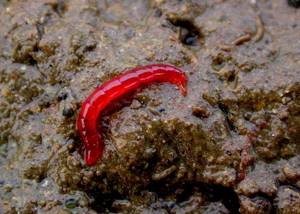
What do bloodworms eat and how to feed them at home?
An important factor is the nutrition of the larvae. In principle, if the conditions of the reservoir from which it was obtained are normal, then the larva has a supply of nutrients in its body that supports its vital functions.
- During the cold season, she eats little, only as a last resort to maintain strength. Therefore, there is no need to specially feed it - after all, during storage it is the winter conditions of existence of this benthic organism that are copied. Therefore, bloodworms do not feed at home, as they hibernate (roughly speaking). But sometimes you can get a weakened larva, of mediocre quality, which has spent its nutrients.
- Signs of this may include pale color and lethargy. Such bloodworms can be fed (both during long-term storage and short-term storage to improve properties before fishing). If the larvae are good, bright red in color and move, then such troubles are not required.
- In the natural environment, mosquito larvae feed on plant and animal debris, as well as various microorganisms in bottom sludge. What to feed bloodworms at home in winter? The simplest and best option is an aqueous solution of a small amount of yeast and sugar. This mixture contains both proteins and carbohydrates.
- When kept dry, a rag or newspaper in which the bloodworms are located is blotted with it, and if they are stored in water, then a little of this feeding should be poured directly into the container. After feeding in the first case, the bloodworms need to be washed in clean water, dried and continued storage. In the second case, the water simply changes.
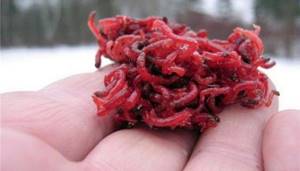
Which bloodworm is suitable for long-term storage
For the success of this event, it is necessary not only to properly store the bloodworms at home, but also to use the larvae themselves of normal quality. The bait is washed in two ways.
On an industrial scale, the larvae are removed and washed using the pipe method using a special pump with a sieve. In this case, many larvae are injured, they will not be stored for a long time and will quickly die. Such bloodworms are supplied in large quantities to large fishing stores and aquarists as fish food. It can be distinguished by a large number of dead individuals; sluggish larvae will have a pale color.
For long-term storage, bloodworms obtained only by hand, using the bag method, are suitable. Therefore, you need to either wash it yourself. Or buy from a seller who obviously sells this hand-washed bait.
In any case, it is better to wash it yourself, since it is not known what temperature fluctuations the store-bought bloodworms fell into. If it was frozen or overheated at least once after being taken out of the reservoir, then it will no longer be stored alive for a long time.
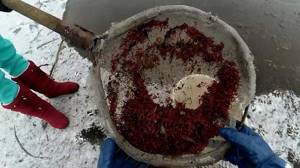
Bag method

Pipe pump
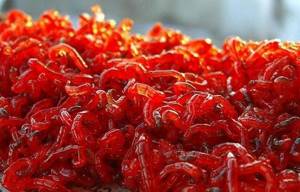
One cycle in the life of a bloodworm
By learning the habits of the main bait, you can achieve greater catches
. It has long been known that small and large bloodworms are the most versatile and effective baits and baits. But what do we know about their lives? How can this knowledge be applied to the benefit of fishing?
Let's start with the small one, or as fishermen call it, the feed bloodworm. It is from these small larvae that the biting mosquitoes hatch, which pester the fisherman so much, from spring to late autumn. They are found in almost any damp place, including roadside ditches, puddles that do not dry out for a long time, swamps and other shallow and deep bodies of water. The shallower the body of water, the faster the larva is ready to turn into a malicious bloodsucker. The mosquitoes that hatch from the larvae have a wedding, and the females lay new eggs in all the damp places where they can. Mosquitoes manage to hatch even in household air conditioners, as long as they have enough moisture there. In general, these are the most unpretentious insects in terms of breeding conditions. The life cycle of the larvae in water is quite short, so the reproduction and emergence of mosquitoes continues throughout the warm season, and mosquitoes do not disappear until frost.
Large bloodworms, which are more often used as bait, have a different, longer life cycle from the moment the larva is born until the next birth of the larva. Unlike small ones, large bloodworms turn into mosquitoes that do not bite. They are noticeably larger in size than bloodsuckers, with a body at least 10 mm in length, slightly greenish in color and do not have a sucking sting. In reservoirs near Moscow, this large mosquito begins to hatch in the first ten days of July, when the water in reservoirs and reservoirs warms up well and begins to bloom. A larva that is ripe for emergence begins to thicken in the head, darkens and takes on the appearance of a comma. This cycle can be easily recreated and observed in a home aquarium, as long as the fish do not have time to eat it. Sometimes in the summer there are bloodworms on sale whose heads have darkened and seem to have swollen a little. This means that this bloodworm is ripe for flight.
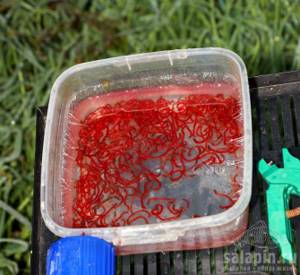
Mature larvae, moving in the water like a seahorse, rise to the surface. The body of the larvae of both small and large bloodworms is covered with a fatty layer, therefore, having reached the surface, the larva is thrown into the water and will never be able to dive under water again. She is simply doomed to have a mosquito hatch from her. On the surface of the water, the larval shell matures for some time, then bursts along the body, and the newly hatched mosquito has a raft, sitting on which it dries, spreads its wings and trains them before taking off, like a chick in a nest before flying. Having gained strength and periodically sitting on the water to rest, the mosquito flies to the shore, where light food and love passions await it. The flight continues around the clock. In the morning you can often see the sides of a boat standing near the shore completely covered with a greenish, swarming mass of mosquitoes that have settled down to rest. Around the boat, the water is boiling with bleak, which, jumping from the water, knocks down the landed mosquitoes and diligently feasts on them. At night, due to the humid air, it is quite difficult for a mosquito to fly, so it takes a long time to get to the shore and with frequent rests. But with the first rays of the sun, pandemonium begins. Having warmed up, mosquitoes immediately rise into the air.
When you spend the night in a tent on the shore, it is almost impossible to miss the sunrise. A strong hum from myriads of insects gradually increases in the air and it seems as if a small plane is hovering over the tent. This mosquito does not live long, plays a wedding, and pregnant females fly to open water to lay eggs. As the eggs mature, the mosquito's abdomen becomes rounder, it becomes heavier, and a moment comes when the insect's strength leaves. A mosquito falls like a stone onto the surface of the water. From the impact, its abdomen bursts from below, and microscopic eggs fall out of it, from which new large bloodworm larvae grow quite quickly, within a month. After a mosquito falls on the water, a small cloudy cloud forms under it, as if a small drop of milk had been dropped into the water. These are the eggs of future larvae. Sitting in a boat on the open water of the Mozhaisk Reservoir, I observed the process of both the flight of a mosquito and its last minutes of life. After take-off, empty shells of former larvae remain on the water, and after dropping the eggs, the corpses of former newlyweds remain on the water. Mosquitoes fall into the water over the entire surface of the reservoir, evenly populating its bottom with future larvae of large bloodworms. In shallow water, where the water warms up earlier, this mosquito flies out first, and as the water warms up in deeper places, the next wave flies out. Thus, the flight of the mosquito continues for almost a month, making serious adjustments to the methods of catching many fish. Depending on the weather, the flight ends with the onset of the first August cold snap. During the period of active emergence of this mosquito, difficulties arise in purchasing bloodworms for fishing on the live food market.
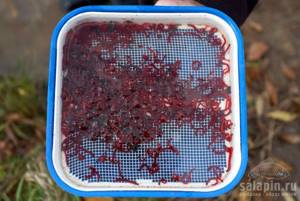
As autumn approaches, the water level in the Moscow Region reservoirs is released, exposing the shallows where the bloodworm larvae have settled. Unfortunately, the larvae cannot swim in order to escape the dangerous drainage zone in time. Without water, the larvae die, emitting a cloying and not very pleasant smell throughout the shallows. Another stage of feasting for migratory birds begins. Flocks of waders, lapwings, wagtails and other small birds occupy the shallows, plucking living and not-so-living larvae from the wet silt. This excellent nutritious food will significantly increase the strength of migratory birds and keep them alert on their long journey to the south.
During the flight of the mosquito, a real feast begins for both insectivorous birds and fish of all breeds. All white fish of any size begin to feed heavily on the most nutritious food. Large, medium and small bream gather in large schools and suck everything on the surface from the surface. It draws in the surface layer of water with its mouth and swallows both the skins of former larvae and the corpses of mosquitoes that have swept away, as well as freshly hatched mosquitoes that have not yet had time to take off. Catching bream from the bottom with any bait at this time of year is useless. It can only sink to the bottom at night, but this does not guarantee catches, since the bream is fed up with the daytime meal. The predator also changes its hunting tactics and relentlessly follows the feeding school of bream, guarding unwary fish of a suitable size. It is better to catch a predator with large oscillating spoons directly under the school, or next to it. In this case, the depth and topography of the bottom do not matter. Bites occur at a fishing depth of 1.5 - 2 m under the flock. Large pike and pike perch are caught. The little thing also enjoys the feast, but near the shore, or in shallow water. All representatives of the fish kingdom are present here, from bleak to small squints, zander, perches, chubs, roaches, etc. There is also a feast for large birds of prey, for which it has become easy to pull out bream and even large bream from the water while they are feeding at the surface and have lost their vigilance from gluttony. During the three to four weeks that this mosquito takes flight, all the fish fill up their fat reserves for the winter, and subsequently their bite noticeably weakens, especially for white fish.
Breakdown
Bloodworm breaker is a dry, finely dispersed substance that, when mixed with a mass of bait, separates each larva from the other. This event somewhat increases the lifespan of the larvae if you store the bloodworms at home. Starch or a special store-bought mixture is used as a breakdown for bloodworms.
Another factor for proper long-term storage is the absence of crowding. Each larva must have access to oxygen in order to breathe. Inside the stuck together lumps, the bloodworm quickly dies, spreading rot around itself and killing even more individuals. This method is very good for preserving bloodworms for fishing in winter, which usually lie in a fairly dense layer of newspaper.
In a container of water
Place live bloodworms in a layer of no more than 10 millimeters in a glass jar with a sieve (or a special plastic cassette with a liner) with settled and cool water. The insert is the same sieve with holes approximately one millimeter in diameter. So, the bloodworms need to be placed on it. After about 15 minutes, live larvae will move into the tray through the holes, and dead ones will remain in the sieve. They should be removed and the remaining ones stored in this cassette in a cool place. This cleansing procedure can be carried out every two days, while changing the water and removing dead individuals.
How to save bloodworms
Storing bloodworms at home comes down to ensuring certain requirements for the life of the larvae, under which they safely wait out the winter. In addition to the necessary conditions mentioned above, there is one more point. An increase in temperature and excess “wetness” serves as an impetus for the development of pathogenic microflora, which kills the larvae.
As a preventive measure, according to reviews from fishermen, the bactericidal agent Polyphepan can be effectively used. It does not poison bloodworms, has no effect on fish (based on plant components), and destroys harmful bacteria. This product is added to the water when the larvae are contained in it; during dry storage, the fabric in which the bloodworms are wrapped is soaked in the drug solution. There are many positive reviews about the use of polyphepane on fishing forums. The drug is sold in pharmacies, the price is about 100 rubles.
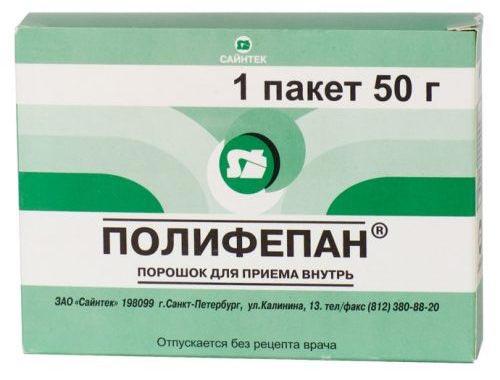
From all of the above, let us summarize what conditions must be met to keep the bloodworm alive:
- Constant temperature 0-10 degrees without changes.
- The larvae were collected by hand and were never cold, overheated or overdried on the way to the fisherman.
- With the dry storage method, the bloodworms should be moistened, but not wet.
- When kept in water, the liquid must be changed frequently.
- If necessary, the larvae can be fed with yeast and sugar.
- The use of polyphepan gives good results.
- The mass should be loose; tightness kills the larvae. Stirring with starch or store-bought ingredients improves shelf life.
- It is strictly forbidden to return larvae that have been fishing in a bloodworm back for storage - everything will spoil.

Breaking down with breadcrumbs before fishing
Large container with silt or sand
Bloodworms can be stored all winter in a large container filled with silt or sand, filled with water. But this is impossible in a city apartment for obvious reasons. It is important to ensure that such an artificial reservoir does not overheat during a thaw and does not freeze to the bottom in severe frost. Applicable for owners of private plots where all this can be placed.
Toilet cistern
You can store bloodworms for several months in a nylon stocking lowered into a cistern (if your wife doesn’t mind). An important condition is that the toilet must be functional so that the water in the barrel is constantly replaced. You also can’t tamp too much, otherwise the bloodworm will die from the crowded conditions. From time to time it is necessary to check the stocking and remove dead individuals manually or pass them through a special blood-worm cassette (more on this below).

Can be stored in a container
Cotton rag
The standard old method, most often used by anglers. This is the “dry” method. As already mentioned, the larvae must be dried (but not overdried!). A good substance - the bloodworm is bright scarlet, shiny, and actively moving. There is no garbage, mold, rot or dead animals among it.
- All this is placed on a cotton rag in a loose, thin layer and wrapped in an envelope. The envelope is moistened with water from a spray bottle (the rag should be slightly damp), after which it must be placed in the refrigerator.
- Once every two or three days you need to check the menagerie and remove dead bloodworms. If something went wrong, the bait began to turn black (die) en masse - everything is washed with clean cold water in a sieve or cassette, dried and placed in a new rag, moistened with a polyphepane solution.
- Previously, when there were no refrigerators, this workpiece was placed on straw, under which a piece of ice was placed. In this way, with some skill and periodic washing, bloodworms can be stored for weeks, and even months.
- Instead of fabric, you can use newspaper (in three layers), which is what sellers in fishing stores do. According to numerous observations, when stored in newspaper, the lifespan of bait is shorter than when using CB.
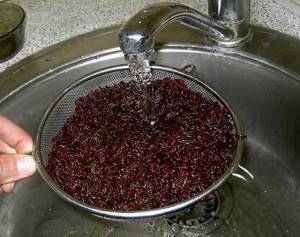
Flushing
Cassette
The cassette is a container into which a mesh with holes about 2 mm in diameter is inserted. Water is poured into the container, and bloodworms are placed in the mesh. After some time, live individuals pass through the holes into the main jar, and dead ones remain on the grid. Ready-made cassettes are available for sale. You can also make your own version from scrap items.
- The amount of bait stored depends on the size of the setup. In any case, you can’t stuff it tightly. The water needs to be changed every two days. This method is also suitable for urban residents, and the lifespan of the larvae will depend on the quality of the water. In principle, bloodworms survive normally in city tap water.
- The cassette can be used to separate live from dead specimens during dry storage. The shelf life depends on the quality of the water and the efforts of the fisherman.
- One nuance is important - since all this needs to be stored in the refrigerator, the replacement water must be cooled to the same temperature before replacing, so that the worms do not experience shock and die.
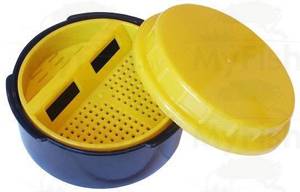
Cassette jar Tonar
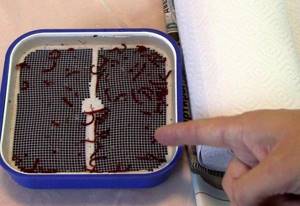
Square cassette
Bloodworm - larva of the long-tailed mosquito
First of all, it is necessary to tell what a bloodworm is, although most anglers are familiar with this bait, not everyone knows where it comes from. A bloodworm is a mosquito larva, but not a common one, whose squeak is so annoying in the evenings, but a long-lasting mosquito. The ruby worm is long, reaching several centimeters. The larvae’s habitat is the muddy bottom of standing reservoirs overgrown with aquatic vegetation. Bloodworms feed on decaying remains of organic compounds; in other words, fish food itself is not averse to “snack” on fish and other animal and plant organisms that have outlived their useful life.
The main method of extraction is washing the bottom layer of sludge using a special grid, from which the washed bloodworms are collected with a special scoop. Larvae are harvested all year round, but the main time of year when larvae are harvested is winter.
Most fishermen do not go out to get bloodworms, they simply buy them at a fishing store or from the getters themselves. And, probably, every angler has more than once wondered about the preservation of this delicate bait.
Short storage
How to properly store bloodworms at home if long-term preservation is not needed? For example, a week or two, for specific fishing marathons. For several days, nothing will happen to the bait if it is stored in the refrigerator immediately in boxes made of wood or foam. The main thing is not to wet them! On the contrary, it is better to dry it if it is too wet. First you need to sort out the bait, leaving only good living specimens.
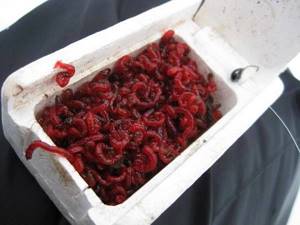
To preserve it for a week, the bottom of the box can be lined with a damp cloth, foam rubber or moss. Some fishermen place grated potatoes (from which excess water is previously squeezed out) and crushed cabbage leaves on the bottom and top of this sandwich.
There is a method when the larvae are placed in a whole potato with the core cut out. Sabaneev also recommended using dried tea leaves - but there is a drawback to this method. The larvae are then difficult to clean from the tea leaves. All this stuff should not be wet, but only slightly damp, and it should also be stored in the refrigerator.
Methods for keeping bloodworms alive at home can and should be combined, looking for the most convenient option. The main thing is to keep in mind the conditions set out in this article and comply with them.
When fishing, the bloodworm is stored in the bosom, since the bait cannot be frozen, otherwise it will quickly deteriorate. In the summer, on the contrary, you need to save them from the heat and keep them, for example, in a thermos with ice.
If you have a slightly damaged bait, you can revive it before fishing. For this:
- Pass through a cassette or manually select live ones and rinse in clean water.
- Dry them on a damp cloth or newspaper, you can lightly sprinkle them with starch.
- Treat with polyphepane.
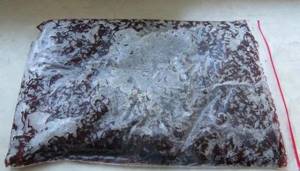
Freezing
Conducted an experiment “How long will bloodworms live” using my storage method
Greetings friends
. A week ago I published a material where I talked about my unique method of storing bloodworms. I believe that this method of storing bloodworms is the best and one of the simplest.
For the experiment, I took several portions of bloodworms separately.
The bloodworm was large, of good quality and very active.
For the experiment, I used 2 bloodworms. I left one round mothbox with bloodworms as is, and stored the second mothbox with bloodworms according to my storage method.
I cut a piece of newspaper, folded it in half to the size of the moth bowl, wet it well under cold running water and placed it in the moth bowl. I sent the bloodworms to the refrigerator. You can read more about this storage method here.
The first few days I did not touch the bloodworms at all, because even with normal storage the bloodworms will feel good.
Day 3.
The third day came and the first bloodworm check came. With my storage method, the bloodworms were all alive and vigorous.
During normal storage, the bloodworms were a little lethargic, but they were also active and without loss.
Day 5.
On day 5, the bloodworms are still in good condition, although the activity of the bloodworms in the round bloodworm begins to decline.
Day 6.
The 6th day of storage has arrived and it’s time to check the bloodworms. During my storage, the bloodworm continues to behave very actively, but with normal storage, the bloodworm no longer really wants to move. In principle, you can see everything in the video.
Day 7
A week has passed. When stored this way, the bloodworm looks cool, is all alive and moves well.
But in the round bloodworm container there were problems when storing bloodworms normally. About 30% of the bloodworms were dead and they hardly moved.
Day 10
On the tenth day, I took the bloodworms out of the refrigerator and began checking. The bloodworms in the round bloodworm were almost motionless, most of the bloodworms had died, and a pungent odor began to appear. We can assume that the bloodworm is gone, since I would not recommend using it with such a smell.
Additional options
Additional bait storage options include:
- A tin can in which we make many holes with a nail to allow air to enter. Carefully sharpen the sharp ends resulting from making holes using a file. The jar is wrapped in 3 layers of gauze and placed in cool running water. The bloodworms are placed in a thin layer at the bottom of a tin container.
- Freezing bait is an equally interesting and effective method. Thoroughly washed larvae are dried and placed in the freezer. An ice tray is perfect for this purpose. Each of the cells is filled with worm-like specimens and filled with water. After wrapping the mold with oilcloth material, we place it in the freezer. By preserving bait using this method, you can ensure the safety of nutrient substances for many months. Thawed fish delicacy should be used urgently. Larvae cannot be re-frozen.
